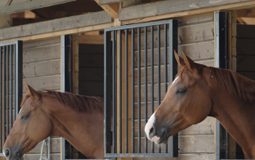 |
Laminitis is a devastating disease that can affect any horse, from the top competitor to the backyard companion. Pfizer Animal Health and the National Thoroughbred Racing Association Charities–Barbaro Memorial Fund have joined forces to educate horse owners on the importance of finding a cure for laminitis, and to honor the memory of the late Kentucky Derby winner Barbaro, who died from complications of the disease.
“Laminitis is a disorder that has challenged veterinarians and plagued horse owners both emotionally and financially,” says Robert Holland, DVM, Ph.D., senior veterinarian at Pfizer Animal Health. “While the exact cause of laminitis remains a mystery, there are many key factors that are believed to increase the risk of occurrence. Therefore, with careful management practices, horse owners and barn managers can do their part to help minimize the risk of laminitis.”
Research performed over the last several decades has shown that certain factors may trigger the onset of the disease, such as digestive upsets caused by grain overload or abrupt changes in diet; sudden access to lush forage; toxins released in the horse’s system; or retained placenta in mares after foaling. As the tragic case of Barbaro exemplifies, excessive weight bearing on one leg after an injury can lead to laminitis. Metabolic disturbances, including but not limited to severe colic or high fever, may also cause problems. Environmental conditions, such as the ingestion of black walnuts, have also been shown to predispose horses to laminitis.
Veterinarians have come to understand that once a horse has developed laminitis, there is a high chance of recurrence. Therefore, extra care and management are recommended for any horse that has had this condition. Affected horses may require a modified diet and routine hoof care, which may include trimming and therapeutic shoeing. Putting the horse on a good health maintenance schedule is also recommended and should include a parasite control plan with regular deworming and fly control, as well as routine vaccinations. In addition, horses prone to laminitis should not graze in lush pastures, particularly during the morning and late afternoon hours. While these management practices are important for all horses, they are particularly critical in helping to prevent the recurrence of this disorder.
“Although we have learned a great deal from the research that has been done on laminitis, at this time there is no fool-proof way to prevent or cure the condition,” Holland says. “We are so pleased to support the NTRA’s Barbaro Memorial Fund, which will allow substantial funding for additional research, which could indeed lead to a cure for laminitis.”






Interesting. Hope they find the cure so no horse has to suffer.
I hope they do find a cure for laminitis because I think no horse should have suffer.
good article
glad to here something is being done!
This good news that they’re working to combat such a deadly problem.
I think giving Laminitis such a diversified reason for “cause” is a gimmic to mislead the public to provide research monies. When in fact there can be only “ONE” actual cause of this disease.
Next it will be Oswalds’ fault!!!!!!